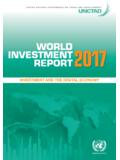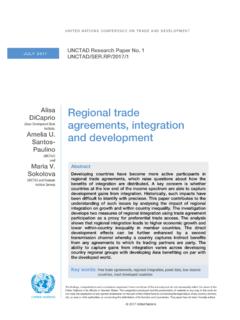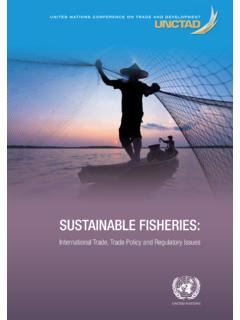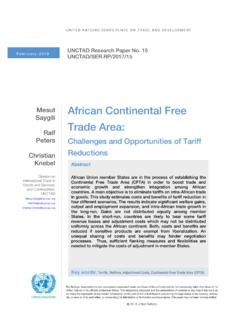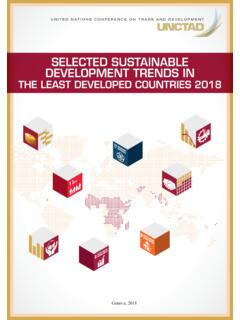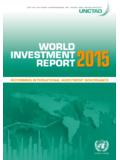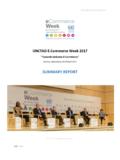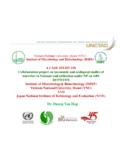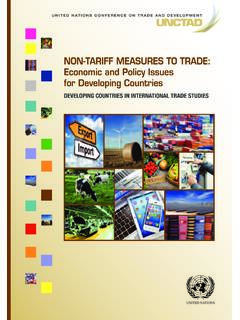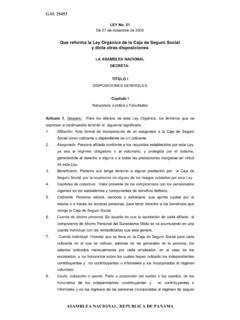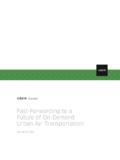Transcription of FOREIGN INVESTMENT IN DEVELOPING …
1 FOREIGN INVESTMENT INDEVELOPING COUNTRIESDoes it Crowd inDomestic INVESTMENT ?Manuel R. Agosin andRicardo MayerNo. 146 February 2000We wish to thank Sanjaya Lall, Karl Sauvant and Zbigniew Zimmy for their useful comments on anearlier draft. Part of this work was undertaken on behalf of UNCTAD as an input into the WorldInvestment Report, ii -The opinions expressed in this paper are those of the authors and do not necessarily reflect theviews of UNCTAD. The designations and terminology employed are also those of the Discussion Papers are read anonymously by at least one referee, whose comments aretaken into account before on this paper are invited and may be addressed to the authors, c/o Editorial Assistant*,Macroeconomic and Development Policies, GDS, United Nations Conference on Trade andDevelopment (UNCTAD), Palais des Nations, CH-1211 Geneva 10, Switzerland.
2 Copies ofDiscussion Papers and Reprint Series may also be obtained from this address. New Discussion Papersare available on the website at: *Tel. 022 ; Fax ; E-mail: classification: E22, F21, F23, iii THEORETICAL MODEL OF INVESTMENT WITH FOR CROWDING IN OR CROWDING 1 - FOREIGN INVESTMENT IN DEVELOPING COUNTRIESDoes it Crowd in Domestic INVESTMENT ?Manuel R. Agosin andRicardo MayerDepartment of Economics, University of Chile, SantiagoThis paper assesses the extent to which FOREIGN direct INVESTMENT in developingcountries crowds in or crowds out domestic INVESTMENT .
3 We develop a theoretical model ofinvestment that includes an FDI variable and we proceed to test it with panel data for theperiod 1970 1996 and the two subperiods 1976 1985 and 1986 1996. The model is runfor three DEVELOPING regions (Africa, Asia and Latin America). One version of the modelallows us to distinguish crowding in and crowding out effects for individual countrieswithin each region. The results indicate that in Asia but less so in Africa there hasbeen strong crowding in of domestic INVESTMENT by FDI; by contrast, strong crowding outhas been the norm in Latin America.
4 The conclusion we reach is that the effects of FDI ondomestic INVESTMENT are by no means always favourable and that simplistic policiestoward FDI are unlikely to be direct INVESTMENT (FDI) is prized by DEVELOPING countries for the bundle of assets thatmultinational enterprises (MNEs) deploy with their investments. Most of these assets are intangible innature and are particularly scarce in DEVELOPING countries . They include technology, managementskills, channels for marketing products internationally, product design, quality characteristics, brandnames, etc.
5 In evaluating the impact of FDI on development, however, a key question is whetherMNEs crowd in domestic investments (as, for example, when their presence stimulates newdownstream or upstream investments that would not have taken place in their absence), or whetherthey have the opposite effect of displacing domestic producers or pre-empting their is a rather important issue. In recent theoretical and empirical work, INVESTMENT has beenidentified as a key variable determining economic growth.
6 Thus, if FDI crowds out domesticinvestment or fails to contribute to capital formation, there would be good reasons to question itsbenefits for recipient DEVELOPING countries . Moreover, given the scarcity of domestic entrepreneurshipand the need to nurture existing entrepreneurial talent, a finding that MNEs displace domestic firmswould also cast doubts on the favourable development effects of FDI. These are all the more important- 2 -questions when one considers that FDI is far from being a marginal magnitude.
7 As can be seen intable1, FDI, as a share of total gross fixed capital formation is a significant and growing magnitude indeveloping countries . In fact, FDI is a much larger proportion of INVESTMENT in DEVELOPING than indeveloped paper addresses the question of whether FDI causes crowding in (CI) or crowding out (CO)of domestic INVESTMENT . Chapter I lays out the issues involved. In chapter II we propose a theoreticalmodel for INVESTMENT in DEVELOPING countries that includes an FDI variable.
8 Chapter III presents theresults of econometric tests of the model for Africa, Asia and Latin America, using panel data for1970 1996. The main conclusions of the paper are given in chapter 1 Developed and DEVELOPING countries :FDI inflows as a percentage of gross fixed capital formation(Percentage)Region1986 19911992 1996 Developed Latin and Eastern :UNCTAD, World INVESTMENT Report, various THE ISSUESI nvestment by MNEs contributes directly to overall INVESTMENT , because it is part of it.
9 Indeed,domestic INVESTMENT (Id) plus investments undertaken by MNEs (If) ought to add up to total grossinvestment (I).fdIII+ If is usually thought of as FDI. This formulation is, of course, an over-simplification, since FDI isnot equivalent to new investments by FOREIGN firms. FDI is a financial balance-of-payments concept;on the other hand, INVESTMENT is a real national accounts variable. Much FDI never becomes- 3 - INVESTMENT in the real sense: mergers and acquisitions (M&As) are mere transfers of ownership ofexisting assets from domestic to FOREIGN firms.
10 In some countries investments by MNEs could exceedFDI. This is the case of investments financed through borrowings on domestic capital markets. Thisphenomenon is more widespread in developed than in DEVELOPING countries . In the latter, borrowingcosts on domestic financial markets are normally much higher than on international markets, and thisusually discourages domestic borrowings by crucial question as regards the development impact of FDI is the extent to which it affectsinvestment by domestic firms (Id).
